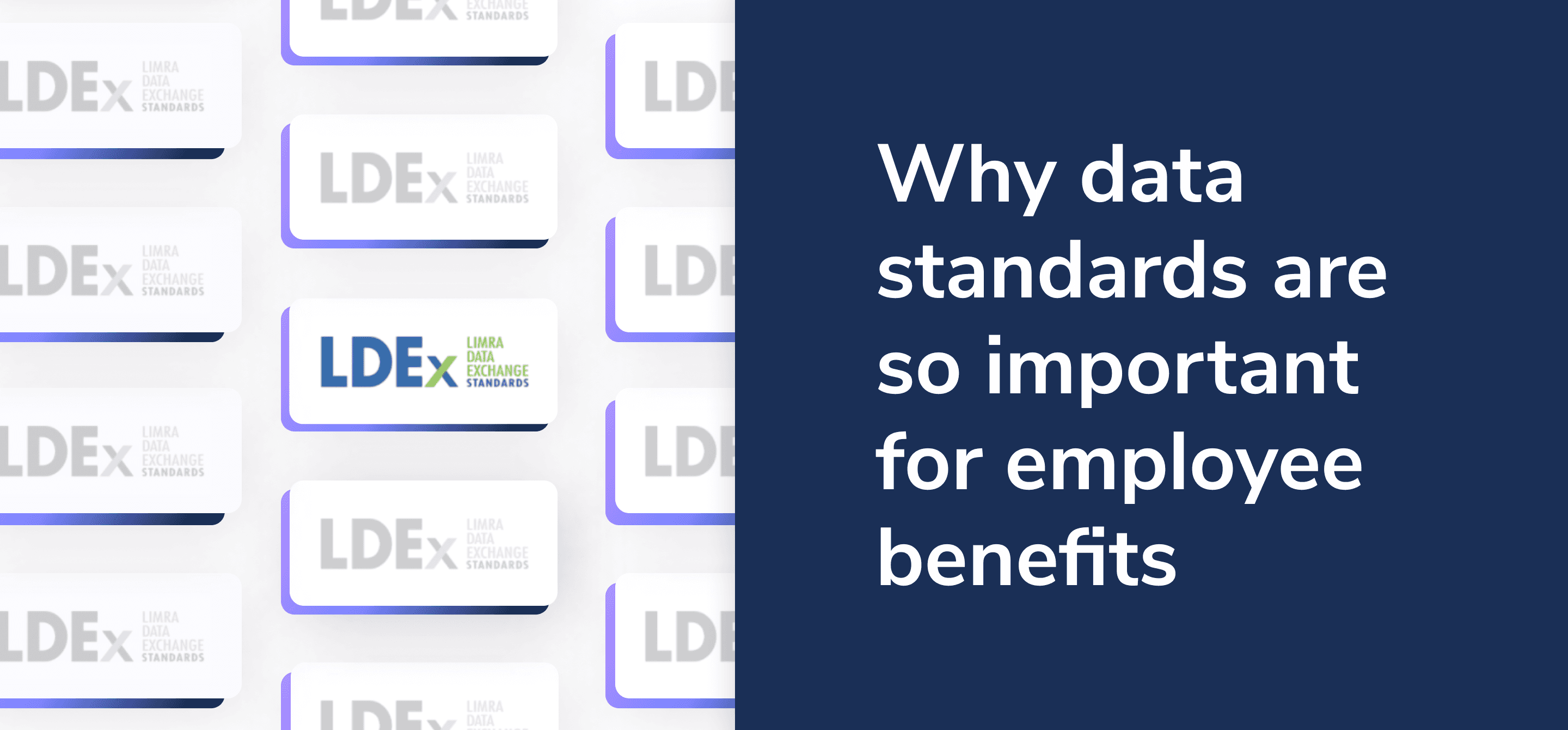
Jul 20, 2022
Why data standards are so important for employee benefits
Across every industry, establishing standards is essential to accelerating innovation and improving the customer experience. In this article, Noyo Head of Solutions Eddie Choi breaks down the possibilities for everyone in the employer benefits space.
Eddie Choi
Across every industry, establishing standards is essential to accelerating innovation and improving the customer experience.
Just as data standardization and APIs have made it possible to move data seamlessly between banks, lenders, investment accounts, and consumer tech, the same connectivity is emerging today across group benefits. That’s why the work LIMRA is doing with their LIMRA Data Exchange Standards® to help standardize data exchange for employee benefits is so exciting.
As Head of Solutions at Noyo (a proud LDEx Committee member), I spend a lot of my time championing LDEx’s benefits to our industry. The opportunity is massive, especially for companies who embrace a dynamic, industry-wide ecosystem, where all stakeholders share data seamlessly and in real time.
This is exactly what Noyo is building and why we’re such strong advocates for data standards like LDEx. Any company interested in adopting LDEx can easily realize the benefits of Noyo.
We realize the path to adopting data standards for employee benefits looks different for every company. To help our partners on the fence, here’s a breakdown of LDEx basics, the impact of standardization, and how it informs our work at Noyo.
In this article:
The rise of data standardization in benefits
Why companies adopt LDEx and alternatives
How LDEx informs our work at Noyo
Unlocking innovation begins with data standards
The rise of data standardization in benefits
For a long time, insurance companies and their partners didn’t have a standard way of exchanging information, so carriers often developed their own methods and the rest of the industry did their best to adapt. This approach worked okay with traditional distribution models that relied on legacy systems and EDI files, but as modern software evolved, so did consumer expectations.

Given the high operational costs of legacy systems and the rise in technology-driven benefits software, LIMRA was approached by carrier members to help broker solutions for data standards and how companies communicate key information like coverage elections, eligibility, and ongoing member changes. A large group of industry stakeholders was brought together to make it happen, and thus, LDEx was born after five years of iteration.
What is LIMRA Data Exchange (LDEx)?
LDEx is a set of published requirements that make it clear for insurance carriers and benefits software platforms to exchange information when it comes to employee benefits, including terms and format, which help ensure consistency and error reduction.
The business benefits of LDEx include:
Top-line revenue growth
Faster speed to market
Fewer bottom-line expenses
Nimbleness in the face of change
Why companies adopt LDEx and alternatives
Many prominent insurance carriers and benefits software platforms have embraced LDEx for the efficiency and cost-savings outlined above. They’ve seen the impact firsthand of having a common language to exchange information.
There are three main reasons to adopt LDEx for carriers and benefits software:
To get ahead of the curve. While the industry is in the “early adopters” phase of LDEx Standards, market pressure to adopt will only increase as more companies embrace LDEx. For organizations on the fence, it’s important to ask: How will being left behind impact your bottom line as competitors move forward with consumer-led solutions?
Return on investment. A single carrier can take months of development. Adopting LDEx means less work dedicated to dozens (if not hundreds) of unique carrier requirements. For example, say you have 10 carriers to connect to, you can cut costs by investing in one standard integration across all 10 rather than 10 unique ones.
To drive innovation. As more of the industry comes on board, LDEx will quickly become the de facto standard for how we all share information. This will help speed up the opening up of insurance and employee benefits data to third-party products and solutions, as well as collaboration with new partners outside of the industry.
The alternative to LDEx
If a company decides not to adopt LDEx, they can either choose to code to every insurance carrier’s proprietary requirements (if you’re a benefits platform) or hope every benefits platform adopts their proprietary format.
What LDEx supports now and what’s next
LDEx currently supports almost all group insurance lines of coverage across medical, ancillary, worksite, and flex spending. It recently extended over to Employee Assistance Program (EAP) and leave management as well. Implementation solutions come as XML Structured File or Batch API (JSON or XML).
There are two exciting releases on the horizon. First, Benefits Configuration Management (spanning plan rules, rates, and details) that integrate with the benefits software platform. Second, an upgrade of all connection transmission types to a REST API, which brings near real-time eligibility, micro services, and enrollment member transactions to finally replace weekly full batch files.
How LDEx informs the work we do at Noyo
Noyo sits on the LDEx Standards Committee for a few reasons. One, we get to be part of a dedicated group of organizations helping lead the way toward a more open and connected benefits ecosystem. This is an essential part of our mission and five-year plan. It allows us to actively participate in discussions while informing and being better informed on the problems the industry is facing.
Second, LDEx allows us to support a standard method of data exchange where there is already broad adoption. This makes it easier for insurance carriers and benefits software platforms to realize the benefits of Noyo’s API solutions — and it better positions our partners to connect with more of the industry as they grow with us.
From a product perspective, building on LDEx Standards means we can support any partner, regardless of their system in place today, to accept LDEx files. This is essential for companies looking to modernize behind-the-scenes, while staying competitive with partners and mitigating the risks of investing in new solutions.
Unlocking insurance innovation begins with data standards
Initially, LDEx aimed to help move data exchange from the status quo to something streamlined. For the first few years, some in the industry were skeptical that there was even a need for another specification for files, and I’m sure there are those who still feel that way.
But although that’s where LIMRA started, we’re now seeing solutions to market that currently don’t exist. Leave management, case setup, REST APIs — these are big initiatives that will provide a blueprint for those looking to be innovative with others in the LDEx ecosystem.
In the future, with wide enough adoption from the industry, LDEx will help unlock innovation in an open insurance landscape. External collaborations with fintech, big tech, and more will put new products and customer experiences within reach for legacy players and insurtechs alike.
With Noyo, insurance companies and benefits software platforms can accept LDEx files with whatever system they have in place today. Curious to learn more? Reach out to our team!
If you do benefits, you need Noyo
The future of employee benefits is faster, easier, and more automated. Are you ready?

